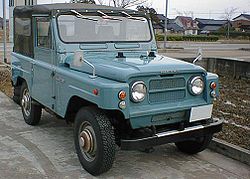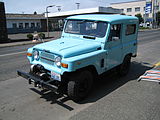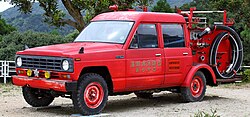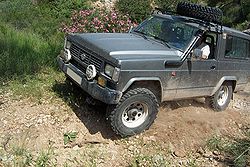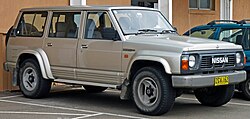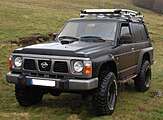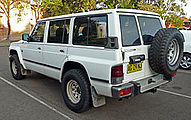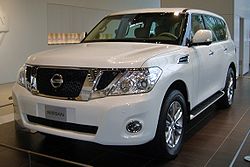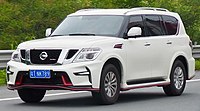Nissan Patrol
| Nissan Patrol | |
|---|---|
| Production period: | since 1951 |
| Class : | Off-road vehicle |
| Body versions : | Station wagon , pickup |
The Nissan Patrol is an all-terrain vehicle that has been produced by the Japanese manufacturer Nissan since 1951 . However, it has only had the name Patrol since 1960. From 1980 it was then marketed on the home market as the Nissan Safari .
Until the 1980s , the Patrol was produced exclusively with leaf springs , until the Y60 appeared in 1988 , which was equipped with coil springs for the first time . Almost all generations that were designed as classic off-road vehicles were available with wheelbases of different lengths .
Until the model change in 2010, it was traditionally manufactured as a classic off-road vehicle with a ladder frame , rigid axles and selectable all-wheel drive . With the model change to the Y62 , the series was redesigned and the vehicle type was changed to SUV , which is noticeable through the introduction of modern construction methods with a self-supporting body and independent wheel suspension . The Y62 generation is also produced as the Infiniti QX80 and marketed in Turkey as the Nissan Safari Royale . The Y61 generation, on the other hand, was known on the Iranian market under the name Nissan Seranza .
From 1960 the Patrol was sold first in Australia and later in New Zealand . For Germany, the history of the Patrol began in 1980 with the Type 160 as the Datsun Patrol and ended in 2009 with the Model Y61 . In Oceania and South Africa , the Patrol is also available as a pickup with either leaf or coil springs.
4W60 / 61/65/66 (1951-1960)
| 1st generation | |
|---|---|
|
Nissan Patrol (4W61, 1955-1958) |
|
| Production period: | 1951-1960 |
| Body versions : | Station wagon , pickup |
| Engines: |
Petrol engines : 3.7-4.0 liters (55-92 kW) |
| Length: | |
| Width: | |
| Height: | |
| Wheelbase : | |
| Empty weight : | |
The first generation 4W60 was created through a tender by the Japanese government in 1950, which urgently needed four-wheel drive off-road vehicles for the police, fire brigade and military due to the infrastructure destroyed by the Second World War . The manufacturers Toyota and Mitsubishi also took part in the competition, with the latter being able to secure the order. Despite this setback, Nissan did not give up the project and decided, just like Toyota with the Landcruiser , to offer the vehicle on the civilian market. In September 1951, finally, the 4W60 went into production and was at the beginning with a 3.7-liter six-cylinder - petrol engine fitted, the original Type 290 came from the Nissan bus and made 75 hp. The shape of the off-road vehicle is very similar to that of the Willys Jeep , but the dimensions of the body are significantly larger on the Nissan. Other distinguishing features of the 4W60 are split windscreens and a Nissan logo embossed in the radiator grille. The 4W60 was not sold as a Datsun in Japan as it was considered a utility vehicle due to its ladder frame and leaf spring construction.
In August 1955 the change to the 4W61 followed , the basic construction of which hardly differs from the previous model. Some chrome parts were mounted on the body that had to be saved on the previous model due to the material shortage prevailing at the time. The radiator grille and the bonnet were refined with it and a chrome logo, partially painted red, adorned the front. Further changes concerned the now one-piece windshield and the engine. A newly developed 3.7-liter engine with 92 hp was installed in the 4W61 , which was later replaced by a 105-hp engine with a displacement of 4.0 liters .
The 105 hp engine was also used in the 4W65 , which only differs from its predecessor in a few optical details such as the radiator grille and bonnet. Models of the 4W65 equipped with the 105 hp engine were given the addition of Patrol. The 4W65 was produced from October 1958, but was replaced by the 4W66 model in December of the following year . This is outwardly the same as its predecessor, but was now also equipped with a new 4.0-liter engine with 125 hp before production was stopped in June 1960 in favor of the successor model.
| Technical data Nissan Patrol (1951–1960) | ||||
| Nissan Patrol | 3.7 | 4.0 | ||
| Construction period: | 1951-1955 | 1955-1958 | 1958-1960 | 1959-1960 |
| Engine type: | Six cylinders - gasoline engine in serial type | |||
| Displacement: | 3670 cc | 3666 cc | 3960 cc | 3956 cc |
| Engine code: | NAK | NB | NC | P40 |
| Max. Performance in min -1 : | 55 kW (75 PS) / 3200 | 68 kW (92 PS) /? | 77 kW (105 PS) / 3400 | 92 kW (125 PS) / 3400 |
| Max. Torque at min -1 : | 206 Nm / 1600 | ? | 264 Nm / 1600 | 284 Nm / 1600 |
| Valve control: | SV | OHV | ||
| Drive type: | Rear-wheel drive, all-wheel drive can be activated | |||
| Transmission: | 4-speed manual transmission | |||
Patrol (Series 60/61, 1960–1984)
| 2nd generation | |
|---|---|
|
Datsun Patrol (1965-1979) |
|
| Production period: | 1960-1984 |
| Body versions : | Station wagon , pickup |
| Engines: |
Gasoline engines : 4.0 liters (92-107 kW) |
| Length: | |
| Width: | |
| Height: | |
| Wheelbase : | 2200-2800 mm |
| Empty weight : | |
With the 60 series , the off-road vehicle was first presented as a patrol. It was produced from October 1960 and was technically almost identical to its predecessor. Only the design was newly developed and the engine also came from the 4W66 model and continued to generate 125 hp from a displacement of 4.0 liters. One of the main technical changes was the relocation of the electrical system, which, in contrast to the previous model, was now higher up and thus allowed a greater fording depth . Interventions in the carburetor , compression and valve opening times in 1965 increased the power to 145 hp.
After this revision, the Series 60 was built almost unchanged until production was discontinued in autumn 1979. Up to this point, only minor cosmetic changes followed. However, a slightly modified version called Series 61 was still produced until summer 1984.
When the license was granted to the Vehicle Factory Jabalpur (VFJ) in India in 1965, production of the 60 series as a Jonga for the Indian army began in 1969 . The name is an acronym for J abalpur O rdnance a N d G un carriage A ssembly and means something like Jabalpur ammunition and weapons van production. Initially, the 4.0 liter Nissan engine was used and replaced in 1994 by a diesel engine developed by VFJ. Production didn't end until 1999.
Model variants
The Series 60 Patrol was available with three frames of different lengths and different bodies. At the start of production, only a short version with a 2200 mm wheelbase was available, but this was supplemented from 1962 by a medium version with 2500 mm and finally from 1968 by a long chassis with a 2800 mm wheelbase. The different body variants based on this were designated with model-specific codes:
| wheelbase | Model code |
|---|---|
| short (2200 mm) | 60 : soft top , K60 : hard top |
| medium (2500 mm) | G60 : soft top, KG60 : hard top, WG60 : wagon , VG60 : van, FG60 : fire engine |
| long (2800 mm) |
62Z-G60 : Pickup , 94Z-G60 : Cab chassis (Pickup without loading area), VH60 : Van, FH60 : Fire engine |
In addition, the model code for vehicles with left-hand drive contained an "L" and the G60 and VG60 were also available as versions for heavy duty, whose abbreviations were supplemented with "H" to G60H and VH60. These models are equipped with reinforced rear differential and tires with a higher load index.
| Technical data Nissan Patrol (1960–1984) | ||||
| Nissan Patrol | 4.0 | |||
| Construction period: | 1960-1965 | 1965-1984 | ||
| Engine type: | Six cylinders - gasoline engine in serial type | |||
| Displacement: | 3956 cc | |||
| Engine code: | P40 | |||
| Max. Performance in min -1 : | 92 kW (125 PS) / 3400 | 107 kW (145 PS) / 3800 | ||
| Max. Torque at min -1 : | 284 Nm / 1600 | 318 Nm / 2000 | ||
| Valve control: | OHV | |||
| Drive type: | Rear-wheel drive, all-wheel drive can be activated | |||
| Transmission: | 3-speed manual transmission | |||
Patrol 160 (1979-1989)
| 3rd generation | |
|---|---|
|
Datsun Patrol (1979-1984) |
|
| Production period: | 1979-1989 |
| Body versions : | Station wagon , pickup |
| Engines: |
Petrol engines : 2.8-4.0 liters (81-107 kW) Diesel engines : 3.3 liters (70-81 kW) |
| Length: | |
| Width: | |
| Height: | |
| Wheelbase : | |
| Empty weight : | |
In November 1979 the production of the new Patrol 160 started in Japan, which was now offered there as a Nissan Safari . The Patrol 160 was the first Patrol model that was first offered as Datsun in Germany . The sales start took place in January 1981 and the offer included the versions with short and long wheelbase.
A gasoline engine and a diesel engine in a six-cylinder in-line design were available as engines . The petrol engine develops 121 hp from a displacement of 2.8 liters and the naturally aspirated diesel achieves 95 hp from 3.3 liters.
At the end of 1983, the engine range was supplemented by a 3.3-liter turbo diesel with 110 hp, which was initially only available for the Patrol with a short wheelbase. This engine only made its debut in the long model in July 1985.
A first facelift was carried out in January 1984, during which, among other things, the previously round headlights were replaced by angular ones and the radiator grille was also changed. At the same time, the conversion from Datsun to Nissan took place.
Production of the Patrol 160 ended in February 1989 .
| Technical data Nissan Patrol (1979–1989) | ||||
| Nissan Patrol | 2.8 |
4.0 (not in Germany) |
3.3 Diesel | 3.3 TD |
| Construction period: | 1979-1989 | 1979-1989 | 1979-1989 | 1983-1989 |
| Engine type: | Six cylinders - gasoline engine in serial type | Six-cylinder - naturally aspirated diesel engine in serial type | Six-cylinder - Turbo Diesel in serial type | |
| Displacement: | 2753 cc | 3956 cc | 3246 cc | |
| Engine code: | L28 | P40 | SD33 | SD33T |
| Max. Performance in min -1 : | 89 kW (121 PS) / 4800 | 107 kW (145 PS) / 3800 | 70 kW (95 PS) / 3600 | 81 kW (110 PS) / 4000 |
| Max. Torque at min -1 : | 280 Nm / 2000 | 318 Nm / 2000 | 215 Nm / 1800 | 255 Nm / 2000 |
| Valve control: | OHC | OHV | ||
| Drive type: | Rear-wheel drive, all-wheel drive can be activated | |||
| Transmission: | 4/5 speed manual transmission | |||
Patrol 260 (1986-1994)
| 4th generation | |
|---|---|
|
Nissan Patrol (1986-1994) |
|
| Production period: | 1986-1994 |
| Body versions : | Station wagon , pickup |
| Engines: |
Diesel engine : 2.8 liters (85 kW) |
| Length: | 4230-4690 mm |
| Width: | 1689 mm |
| Height: | 1980 mm |
| Wheelbase : | 2350-2970 mm |
| Empty weight : | |
The Patrol 260 , which was offered from spring 1986, represents the variant of the 160 that was only produced in Spain . The L28, SD33 and RD28T engines were used. The engine was reduced to just one engine for the German market, a 2.8-liter turbo-charged diesel engine that developed 115 hp and originally came from the Nissan Laurel .
In the summer of 1988, the 260 received a redesign on the front, which now resembled that of the Y60, which was introduced at the same time. The Patrol 260 was offered in Germany parallel to the Y60 until 1993 .
Production of the Patrol 260 in Spain ended in mid-1994.
| Technical data Nissan Patrol (1986–1994) | |
| Nissan Patrol | 2.8 TD |
| Construction period: | 1989-2003 |
| Engine type: | Six-cylinder - Turbo Diesel in serial type |
| Displacement: | 2826 cc |
| Engine code: | RD28T |
| Max. Performance in min -1 : | 85 kW (115 PS) / 4400 |
| Max. Torque at min -1 : | 235 Nm / 2400 |
| Valve control: | OHC |
| Drive type: | Rear-wheel drive, all-wheel drive can be activated |
| Transmission: | 5-speed manual transmission |
Patrol GR (Y60, 1988-1998)
| 5th generation | |
|---|---|
|
Nissan Patrol GR (1988-1995) |
|
| Production period: | 1988-1998 |
| Body versions : | Station wagon , pickup |
| Engines: |
Otto engines : 3.0–4.2 liters (100–129 kW) Diesel engines : 2.8–4.2 liters (85 kW) |
| Length: | 4285-4845 mm |
| Width: | 1930 mm |
| Height: | 1895 mm |
| Wheelbase : | 2400-2970 mm |
| Empty weight : | |
With the introduction of the Y60 type , called the Patrol GR (Grand Raid), in the summer of 1988, coil springs were used instead of leaf springs for the first time in the history of the Patrol.
Like its predecessor, this model was available on the German market with a three-door version with a short wheelbase and a five-door version with a long wheelbase. For Europe, this vehicle was equipped with a 2.8-liter diesel engine, which originally came from the Nissan Laurel and has an output of 116 hp (85 kW).
In Australia, the Y60 was also offered as the Ford Maverick from 1988 to 1994 . At the beginning of 1995 there was a facelift that changed the front in particular.
| Technical data Nissan Patrol (1988–1998) | |||||
| Nissan Patrol |
3.0 (not in Germany) |
4.2 (not in Germany) |
4.2i (not in Germany) |
2.8 TD |
4.2 D (not in Germany) |
| Construction period: | 1988-1998 | 1988-1998 | 1988-1998 | 1988-1998 | 1988-1998 |
| Engine type: | Six cylinders - gasoline engine in serial type | Six-cylinder - Turbo Diesel in serial type | Six-cylinder - naturally aspirated diesel engine in serial type | ||
| Displacement: | 2962 cc | 4169 cc | 2826 cc | 4169 cc | |
| Engine code: | RB30S | TB42S | TB42E | RD28T | TD42 |
| Max. Performance in min -1 : | 100 kW (136 PS) / 4800 | 125 kW (170 PS) / 4200 | 129 kW (175 PS) / 4000 | 85 kW (116 PS) / 4000 | 85 kW (115 PS) / 4000 |
| Max. Torque at min -1 : | 224 Nm / 3000 | 325 Nm / 2800 | 330 Nm / 3200 | 235 Nm / 2400 | 264 Nm / 3200 |
| Valve control: | OHC | OHV | OHC | OHV | |
| Drive type: | Rear-wheel drive, all-wheel drive can be activated | ||||
| Transmission: | 5-speed manual transmission | ||||
Patrol GR (Y61, 1997-2013)
| 6th generation | |
|---|---|
|
Nissan Patrol GR (1997-2003) |
|
| Production period: | 1997-2013 |
| Body versions : | Station wagon , pickup |
| Engines: |
Petrol engines : 4.5–4.8 liters (145–180 kW) Diesel engines : 2.8–4.2 liters (95–155 kW) |
| Length: | 5080 mm |
| Width: | 1940 mm |
| Height: | 1855 mm |
| Wheelbase : | 2970 mm |
| Empty weight : | 2473 kg |
In mid-1997, the Patrol GR Y61 was presented, which was still equipped with rigid axles on coil springs. For the German market launch in the spring of 1998, the new model started with the well-known 2.8-liter diesel engine with modified cylinder head and intercooler with now 130 hp (96 kW), which from May 2000 with a newly developed 3.0-liter diesel engine Direct injection and an output of 158 PS (116 kW) was replaced. Nissan also produced a two-door pickup version of the Y61 series.
In 2000, production for the Asian markets was relocated from the Hiratsuka plant to Makati City in the Philippines . Production for Africa and many emerging countries was relocated from Kanda to Rosslyn (South Africa) in 2001 .
Modifications were made in February 2003 and October 2004, in the latter case the output of the 3.0-liter engine was now increased to 160 hp (118 kW) with common rail injection . At the same time, sales of the Safari Y61 on the Japanese home market were discontinued.
Starting in 2005, part of the Patrol production for many emerging countries was relocated from Nissan Motor Ibérica to Karachi in Pakistan .
The Bundeswehr procured from 2009 a total of 1050 slightly modified vehicles Patrol Y61. They are wrapped in olive green and have an iron cross in black and the words "Bundeswehr" on both doors .
Officially, the sale of the Patrol Y61 in continental Europe was ended by the end of 2009 (Germany September 2009), as production at Nissan Motor Ibérica in Barcelona ended in autumn 2009 and the manufacturing facilities for the production of the Patrol Y61 for the Middle East and the Middle East as well Oceania were relocated to Tangier in Morocco . In Germany, however, there were still 24 new registrations of the Y61 type in 2010.
In the United Kingdom , the Patrol was still available until 2010, since the production of the Patrol Y61, which began in Washington in 1999, was not stopped until 2010.
In 2013, Nissan officially ceased sales of the Patrol Y61 worldwide. In South Africa and Pakistan, the Patrol Y61 will remain in production for the time being.
| Technical data Nissan Patrol 1997–2009 | ||||||||
| Nissan Patrol |
4.5 (not in Germany) |
4.8 (not in Germany) |
2.8 TD | 3.0 Tue |
4.2 D (not in Germany) |
4.2 TD (not in Germany) |
4.2 Tue (not in Germany) |
|
| Construction period: | 1997–? | 2002–? | 1997-2000 | 2000-2004 | 2004-2009 | 1997–? | 1997–? | 1997–? |
| Engine type: | Six cylinders - gasoline engine in serial type | Six-cylinder - Turbo Diesel in serial type | Four-cylinder - Turbo Diesel in serial type | Six-cylinder - naturally aspirated diesel engine in serial type | Six-cylinder - Turbo Diesel in serial type | |||
| Displacement: | 4479 cc | 4759 cc | 2826 cc | 2953 cc | 4169 cc | |||
| Engine code: | TB45E | TB48DE | RD28Ti | ZD30DDTi | TD42 | TD42T | TD42Ti | |
| Max. Performance in min -1 : | 145 kW (197 PS) / 4400 | 180 kW (245 PS) / 4200 | 95 kW (130 PS) / 4000 | 116 kW (158 PS) / 3600 | 118 kW (160 PS) / 3600 | 91 kW (124 PS) / 4000 | 114 kW (155 PS) / 3600 | 114 kW (155 PS) / 3600 |
| Max. Torque at min -1 : | 350 Nm / 3600 | 400 Nm / 3200 | 252 Nm / 2000 | 354 Nm / 2000 | 272 Nm / 2000 | 330 Nm / 2000 | 360 Nm / 2000 | |
| Valve control: | OHV | DOHC | OHC | DOHC | OHV | |||
| Drive type: | Rear-wheel drive, all-wheel drive can be activated | |||||||
| Gearbox, as standard: | 5-speed manual transmission | |||||||
| Gearbox, optional: | ? | - | 4-speed automatic transmission | ? | ||||
Patrol (Y62, since 2010)
| 7th generation | |
|---|---|
|
Nissan Patrol (since 2010) |
|
| Production period: | since 2010 |
| Body versions : | Station wagon |
| Engines: |
Petrol engine : 5.6 liters (298–315 kW) |
| Length: | 5160 mm |
| Width: | 1995 mm |
| Height: | 1940 mm |
| Wheelbase : | 3075 mm |
| Empty weight : | 2845-2885 kg |
With the introduction of the seventh generation of Patrols (type Y62 ) at the beginning of 2010 , Nissan breaks with the previous tradition of this series. The new Patrol is no longer a classic off-road vehicle, but was designed as a luxurious SUV . The reason for this is that with the new generation in North America and other markets the Infiniti QX should be replaced, which is why it is marketed there and in China , Mexico and the Middle East as the Infiniti QX80 .
The Patrol is still based on a classic ladder frame, but the rigid axles used in the predecessors gave way to an all-round independent wheel suspension. The now permanent all-wheel drive is electronically controlled and has a reduction ratio and four driving programs with which the vehicle can be adjusted to different driving surfaces: sand, road, rock and snow. It is powered by a 5.6 liter V8 petrol engine that has an output of 298 kW (405 hp) and a maximum torque of 560 Nm; a diesel engine is no longer available. A 7-speed automatic converter is the only transmission option.
The current Patrol is no longer offered in Europe and is primarily intended for the Middle East, Oceania and markets in Asia and Africa . In Turkey , the series is marketed as Nissan Safari Royale .
In the Middle East, Nissan offers the Patrol as Patrol Nismo . In this the 5.6-liter gasoline engine develops 315 kW (428 hp).
| Technical data Nissan Patrol (since 2010) | |
| Nissan Patrol | 5.6 |
| Construction period: | since 2010 |
| Engine type: | Eight cylinders - gasoline engine in V-type |
| Displacement: | 5552 cc |
| Engine code: | VK56VD |
| Max. Performance in min -1 : | 298 kW (405 hp) / 5800 |
| Max. Torque at min -1 : | 560 Nm / 4000 |
| Valve control: | DOHC with VVEL |
| Drive type: | all wheel drive |
| Transmission: | 7-speed automatic transmission |
| Empty weight: | 2845-2885 kg |
| Acceleration 0-100 km / h: | 6.6 s |
| Top speed: | 210 km / h |
| Fuel consumption over 100 km (combined): | 14.5 l super |
| Tank capacity: | 100 l |
Wheelbases
Leaf spring patrols
Japan production until 1989
- 160 / K160 = short wheelbase, WG160 / VG160 = long wheelbase
Spain production from 1989
- K260 = short wheelbase, W260 = long wheelbase
Coil Spring Patrols
Japan production
- Y60 = short wheelbase, GY60 = long wheelbase (1988–1998)
- Y61 = short wheelbase, GY61 = long wheelbase (1997-2009)
Individual evidence
- ↑ 1951 Nissan Patrol 4W60 model. ( Memento of the original from August 11, 2010 in the Internet Archive ) Info: The archive link was inserted automatically and has not yet been checked. Please check the original and archive link according to the instructions and then remove this notice. In: earlydatsun.com , accessed on August 22, 2010.
- ↑ 1955 Nissan Patrol 4W61 model. ( Memento of the original from August 12, 2010 in the Internet Archive ) Info: The archive link was inserted automatically and has not yet been checked. Please check the original and archive link according to the instructions and then remove this notice. In: earlydatsun.com , accessed on August 22, 2010.
- ↑ 1959 Nissan Patrol 4W65 Model. ( Memento of the original from August 12, 2010 in the Internet Archive ) Info: The archive link was inserted automatically and has not yet been checked. Please check the original and archive link according to the instructions and then remove this notice. In: earlydatsun.com , accessed on August 22, 2010.
- ↑ 1960 Nissan Patrol 60 Series. ( Memento of the original from August 12, 2010 in the Internet Archive ) Info: The archive link was inserted automatically and has not yet been checked. Please check the original and archive link according to the instructions and then remove this notice. In: earlydatsun.com , accessed on August 22, 2010.
- ↑ a b c d A Brief History of the Nissan Patrol. In: patrol4x4.co.za , accessed September 1, 2010.
- ↑ a b c d Nissan Patrol Engine Specifications. In: nissanpatrol.com.au , accessed September 1, 2010.
- ↑ This is the new Nissan Patrol. In: 4wheelfun.de , March 7, 2010, accessed on August 22, 2010.
Web links
- History, pictures, data on the Nissan Patrol
- Nissan Patrol History
- The Australian side to the Patrol pickup truck

